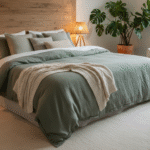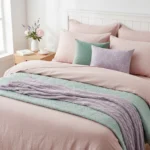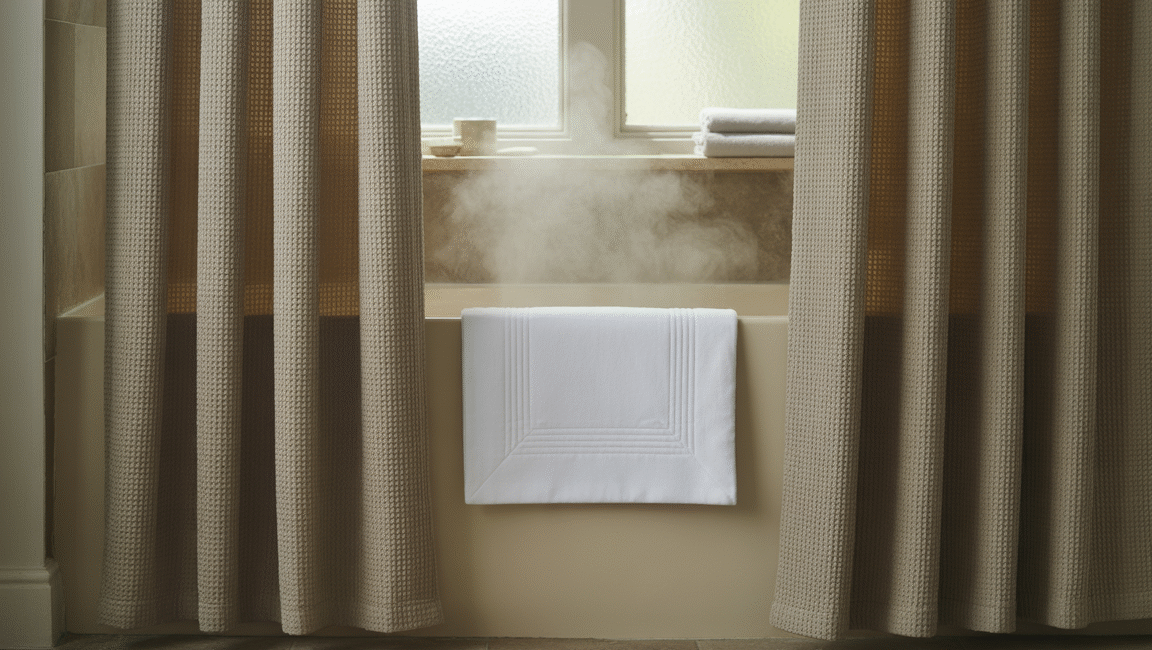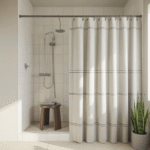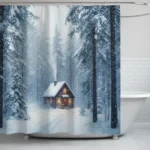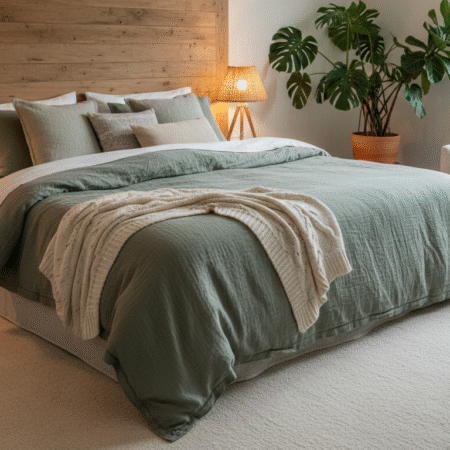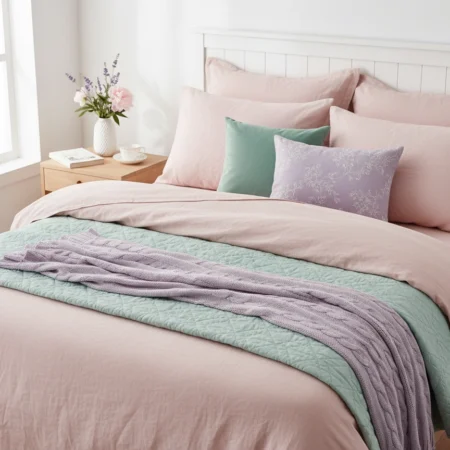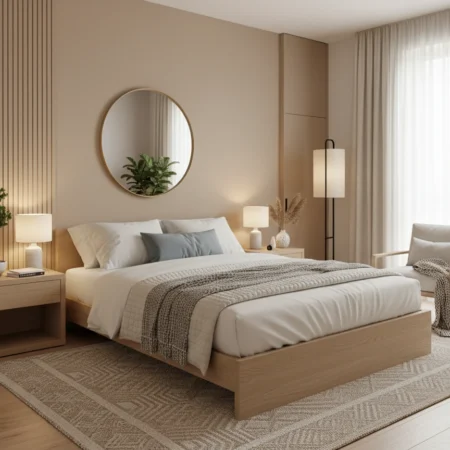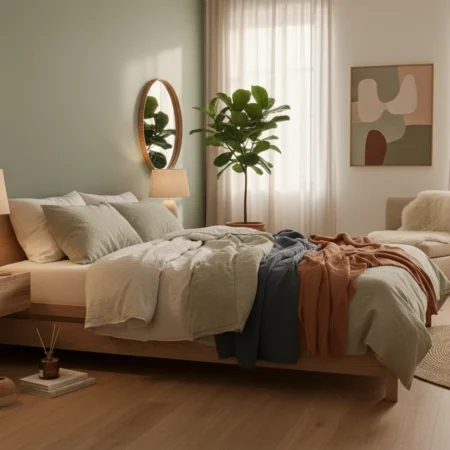Cold bathroom, hot shower, clammy air, chilly draft sneaking in around the curtain… not exactly the luxe winter moment you had in mind, right?
The clever fix is surprisingly simple: upgrade to a double shower curtain setup that adds both warmth and style, without knocking down a single tile.
With the right double shower curtain rod, liner, and outer panels, your everyday shower starts to feel like a mini spa.
You get better steam retention, fewer splashes on the floor, and a chance to dress your bathroom the way you’d dress yourself for winter—layered, cozy, and a little bit glamorous.
From hotel-style white panels to a double swag shower curtain with valance, you can mix and match ideas until your bathroom finally feels as luxurious as you deserve.
Quick Guide: What Is a Double Shower Curtain and Why Use One in Winter?
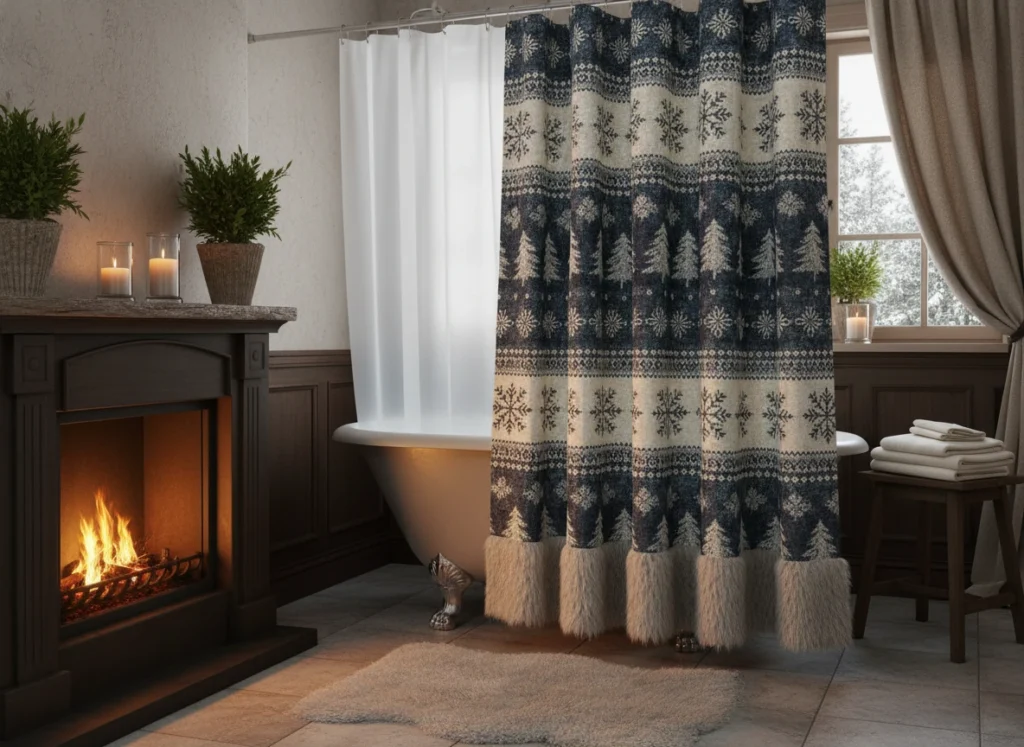
A double shower curtain setup simply means you have two layers instead of one.
Most often, that’s a practical inner liner to keep water in, plus a decorative outer curtain or a pair of outer panels on a double shower curtain rod.
You can hang them with regular hooks or, even easier, double shower curtain rings that hold both layers at once.
In winter, that extra layer works like a cozy coat for your shower.
It helps trap steam, soften cold drafts sneaking in around the edges, and keeps your bathroom from feeling like an ice cave the moment you step out.
Because the space feels warmer and more enclosed, even a quick rinse starts to feel more like a mini spa session.
A double panel shower curtain also looks instantly more luxe than a single, flat sheet of fabric.
Two panels that meet in the middle frame the tub or walk-in shower, just like real drapery, which gives your bathroom that boutique-hotel vibe.
Even simple double shower curtain ideas bathroom-wise can make the whole room feel more finished and intentional.
Getting started is straightforward.
Pair a reliable, easy-to-clean liner with a thicker outer curtain you love, then hang them on a double rod or use double hook shower curtain rings on your existing bar.
From there, you can play with different fabrics, colors, and layouts all winter long without changing the basic setup.
Choosing the Right Double Shower Curtain Rod, Rings, and Hardware
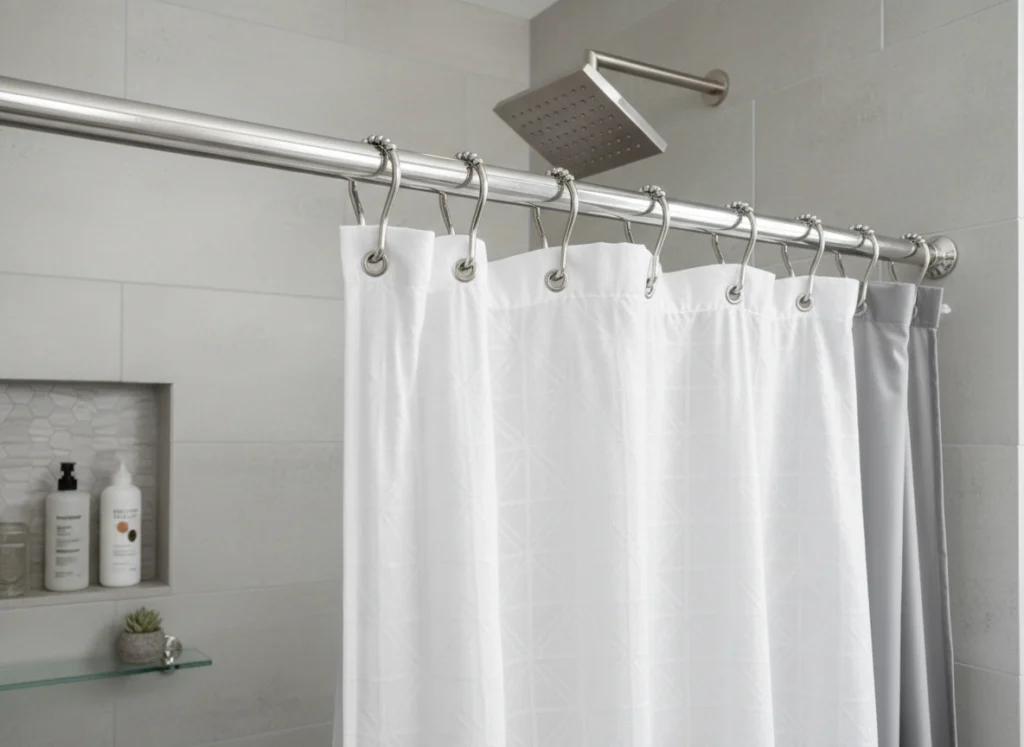
The hardware you choose makes or breaks your double shower curtain ideas.
A sturdy, good-looking rod plus smooth-gliding rings will make daily use feel easy instead of annoying.
Think of it as the “invisible luxury” that quietly supports your whole winter bathroom upgrade.
Start with a quality double shower curtain rod or a standard rod paired with double shower curtain rings.
A double rod lets you separate the liner and the outer curtain completely, while double hook shower curtain rings let you hang two layers on a single bar.
Both options work; the right choice depends on your space and how much visual layering you want.
Finishes matter more than you’d think.
Brushed nickel, black, or warm brass instantly make a basic double panel shower curtain look intentional and more high-end.
If you’re aiming for a luxe winter bathroom look, match the rod and rings to your faucet or cabinet hardware so everything feels cohesive.
Don’t forget the practical side.
Look for rods that install securely without sagging in the middle, especially if your outer curtain fabric is heavier for warmth.
And choose double glide shower curtain rings that slide smoothly, so opening and closing two layers doesn’t feel like an arm workout.
Straight vs Double Curved Shower Curtain Rods
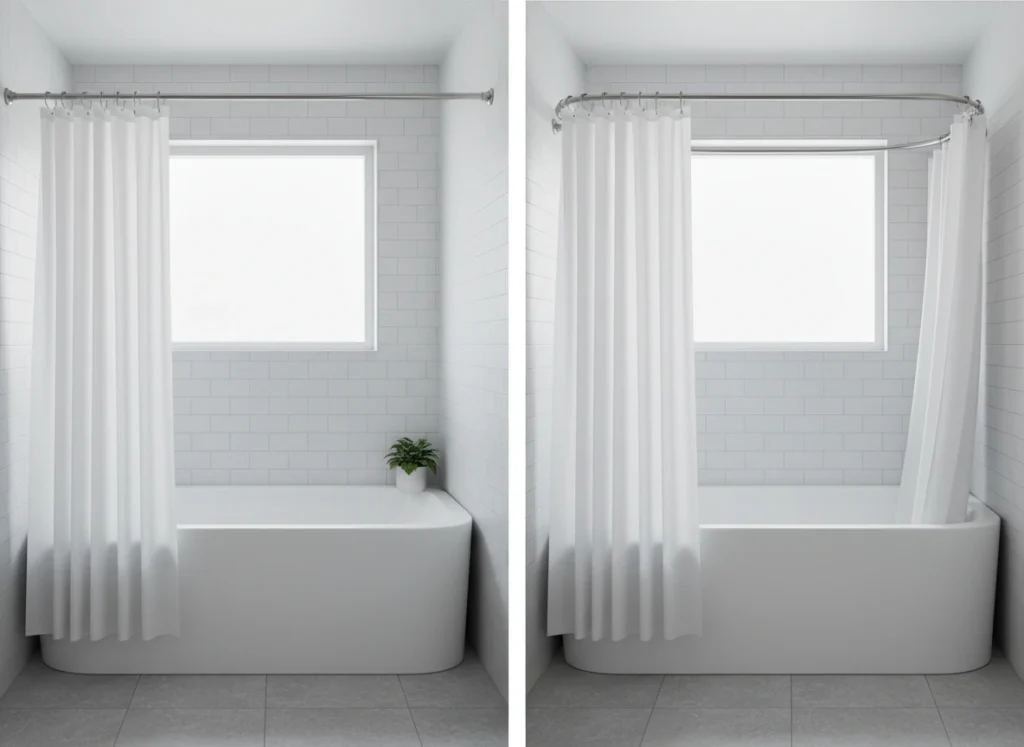
A straight rod is the simple, space-saving classic.
It works well in narrow bathrooms and is usually the easiest option if you’re upgrading to double shower curtain ideas on a budget.
The downside is that it can feel a bit tight once you add a liner and a fuller outer curtain.
A double curved shower curtain rod bows out into the room, giving you more elbow room and a softer, spa-like feel.
That curve also helps your double panel shower curtain hang in a graceful arc, which instantly looks more luxurious.
If your bathroom can spare a few extra inches, a curved double shower curtain rod is often the most “wow” option.
In winter, that extra curve can help keep the liner from clinging to you and reduce drafts sneaking around the edges.
The inner rod can hold a snug, water-blocking liner, while the outer rod shows off your decorative curtain.
Together, they create a cocoon-like shower that feels warmer and more comfortable on chilly mornings.
Double Shower Curtain Rings and Double Hook Shower Curtain Rings
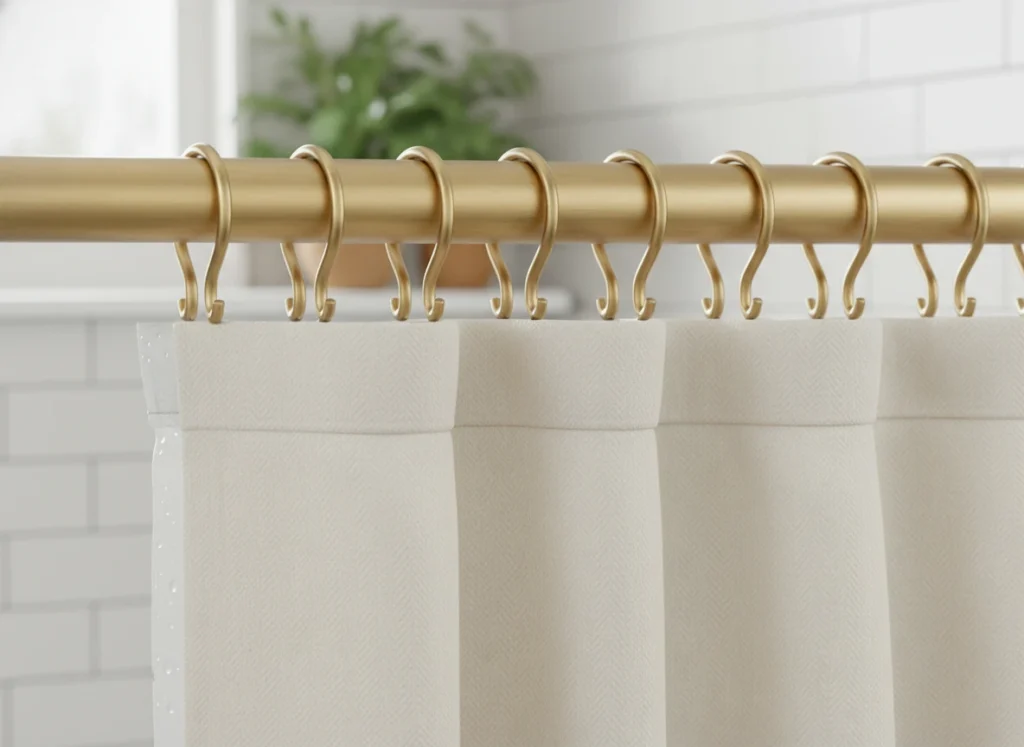
Double shower curtain rings are small, but they solve a big everyday headache.
They’re designed with two hooks or slots, so you can hang a liner on one side and a decorative curtain on the other.
That means you can remove the liner for washing without taking down the whole double panel shower curtain.
Double hook shower curtain rings are especially handy in winter, when liners need more frequent cleaning.
You just unclip the inner liner, toss it in the wash, and hang it back up without wrestling the outer curtain.
The whole process takes minutes instead of becoming a weekend project.
From a style angle, rings and hooks are a quiet way to lean into a luxe look.
Choose finishes like brushed brass, matte black, or polished nickel to complement your double shower curtain rod and other hardware.
Even simple white or neutral double shower curtain ideas feel elevated when the metal details look intentional.
Best Double Shower Curtain Rod for a Walk-In Shower
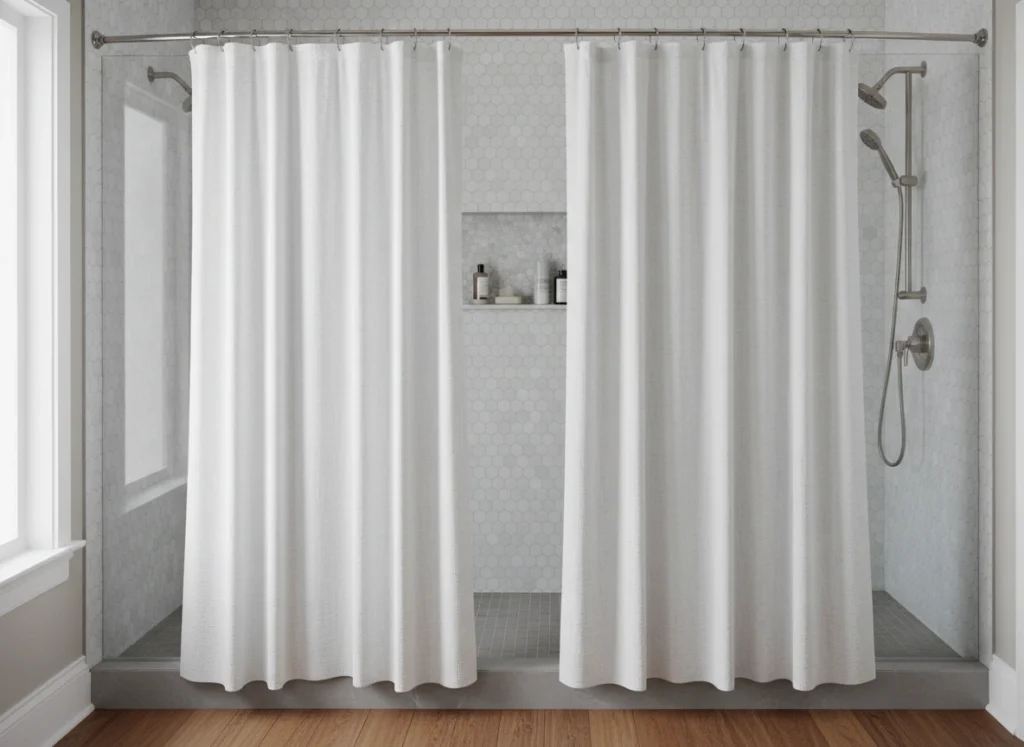
Walk-in showers love a good double shower curtain rod, because they usually need more coverage than a single panel can give.
A straight double rod works well for wide openings like the one in the image: one rod holds the liner panels, and the second carries the decorative curtains.
This setup lets you close everything tight for warmth in winter while still opening the middle for easy access.
If your walk-in shower is on the smaller side or has a corner entry, look for an L-shaped or curved double shower curtain rod for walk in shower layouts.
These rods follow the shape of the tile, so water stays in the shower zone instead of sneaking onto the bathroom floor.
They also frame the opening beautifully, making even a basic tile job feel more luxurious.
For a cozy, luxe feel, consider using two pairs of panels: one set of liners and one set of outer curtains that meet in the center.
This gives you flexible coverage, better steam retention on cold mornings, and that soft “curtained doorway” effect you’d expect in a spa.
It’s one of the most practical double shower curtain ideas for winter if you share a bathroom with others and need privacy plus warmth.
9+ Double Shower Curtain Ideas for a Luxe Bathroom Look in Winter
Here’s where the fun starts: real-life double shower curtain ideas you can actually copy.
Think of this as your winter style menu, from hotel-inspired white panels to cozy textures and bold jewel tones.
You can mix and match these concepts with your existing hardware, so you don’t need a full bathroom remodel to get a luxe look.
As you read through, notice how each idea balances practical warmth with visual drama.
Some focus on layered fabrics that trap steam, while others lean on color, pattern, or length to elevate the space.
Choose one or two to start, then build your own double shower curtain ideas bathroom “capsule wardrobe” over time.
1. Hotel-Style Double Panel Shower Curtain in Crisp White
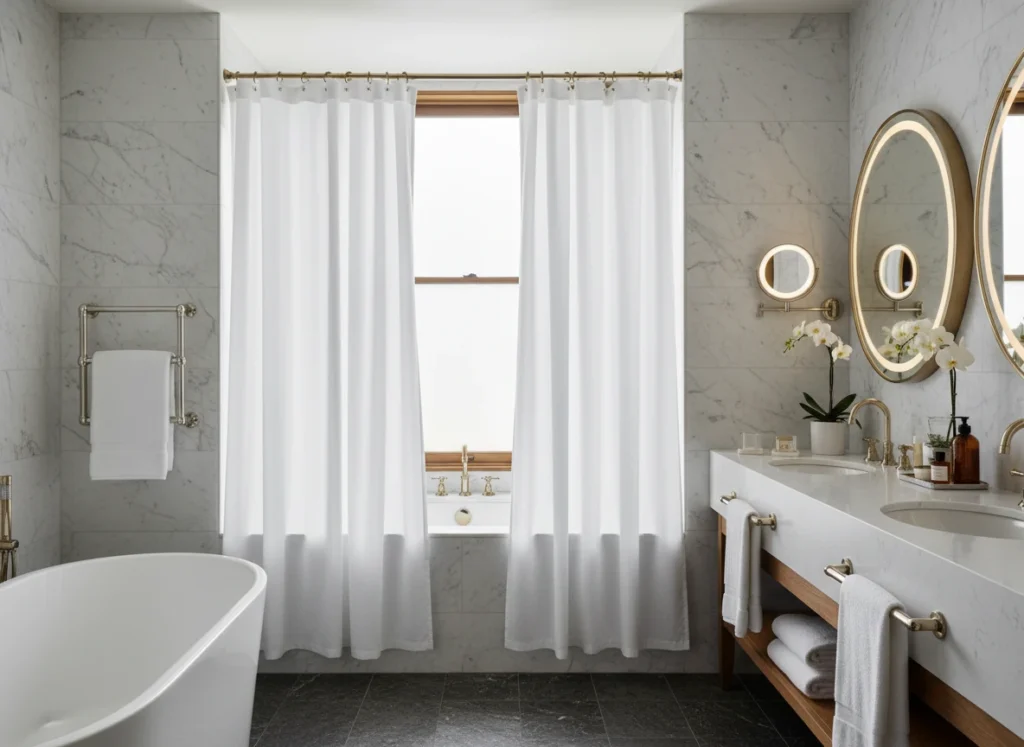
If you want that “checked into a five-star spa” feeling, this is the easiest double shower curtain idea to copy.
Hang a simple white liner inside, then add two crisp white outer panels on a double shower curtain rod or with double hook shower curtain rings.
When the panels meet in the middle, they frame the tub like full-length drapes and instantly make the room feel polished.
White works hard in winter.
It bounces every bit of light around the room, which is a gift on dark mornings, and it pairs beautifully with marble, stone, wood, or whatever tile you already have.
Because the look is so clean, you can layer in plush towels, a thick bath mat, and a candle without things feeling busy.
To keep your hotel-style double panel shower curtain looking luxe, focus on small details.
Choose a slightly heavier fabric for the outer panels so they hang in smooth, elegant folds instead of looking flimsy.
Then add high-quality hardware—think brass or polished nickel rings—to keep this classic white setup from feeling basic.
2. Layered Neutrals: Linen Outer + Thick Liner for Warmth
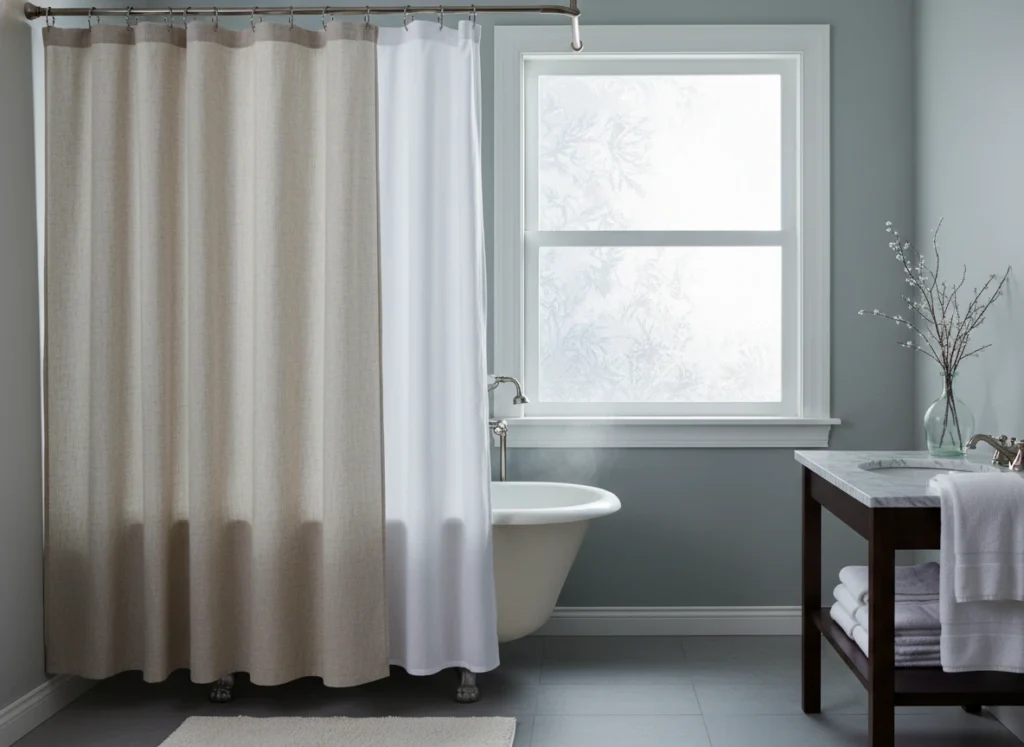
If you like a softer, more relaxed look, layered neutrals are your best friend.
Pair a white or off-white liner with a linen or linen-look outer curtain in sand, oatmeal, or greige.
The result is a calm, cocooning setup that feels very “winter spa in Scandinavia” without trying too hard.
This combo isn’t just pretty; it’s practical.
The heavier outer panel helps block drafts, while the thicker liner keeps water in and steam where it belongs.
You get all the benefits of double shower curtain ideas for warmth, but in a palette that works with almost any tile or paint color.
To keep things from looking flat, play with subtle texture rather than bold pattern.
Choose a slightly slubby linen weave, a herringbone detail, or a gentle heathered fabric on the outer curtain.
Finish the look with warm metal hardware and a plush neutral bath mat to reinforce that cozy winter-luxe vibe.
3. Double Swag Shower Curtain with Valance for Classic Glam
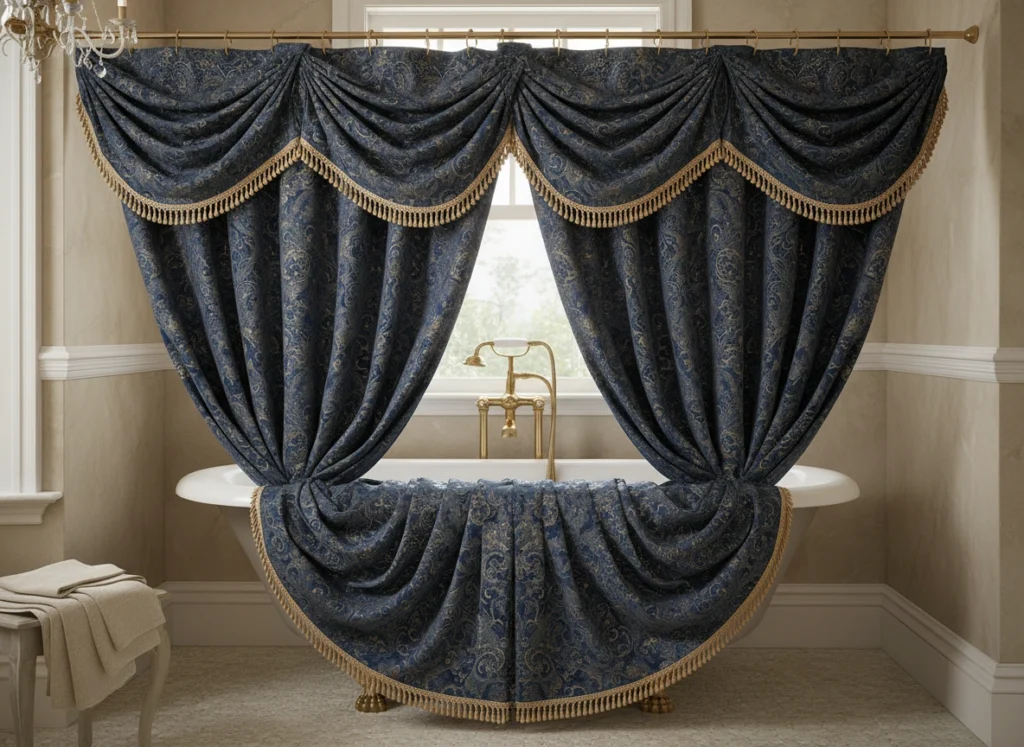
If your style leans more “vintage manor” than “minimal spa,” a double swag shower curtain with valance is pure winter drama.
Here, a decorative valance drapes across the top while two outer panels swoop down and tie back over a simple inner liner.
The layered fabric, tassel trim, and full gathers make the bathtub feel like the star of the room.
This setup is perfect if you want your bathroom to feel like a small, private lounge when it’s freezing outside.
The liner quietly handles the practical work—blocking water and drafts—while the outer swag curtain provides that double curtain visual richness.
It works especially well with clawfoot tubs and traditional fixtures in brass or bronze.
To keep it from feeling over-the-top, balance the ornate curtain with simpler choices elsewhere.
Stick to solid towels, understated rugs, and streamlined storage so the double swag shower curtain remains the main event.
If you love period dramas or old-world hotels, this is one of the most satisfying double shower curtain ideas to try.
4. Modern Minimal: Double Panel Shower Curtain in Solid Color Blocks
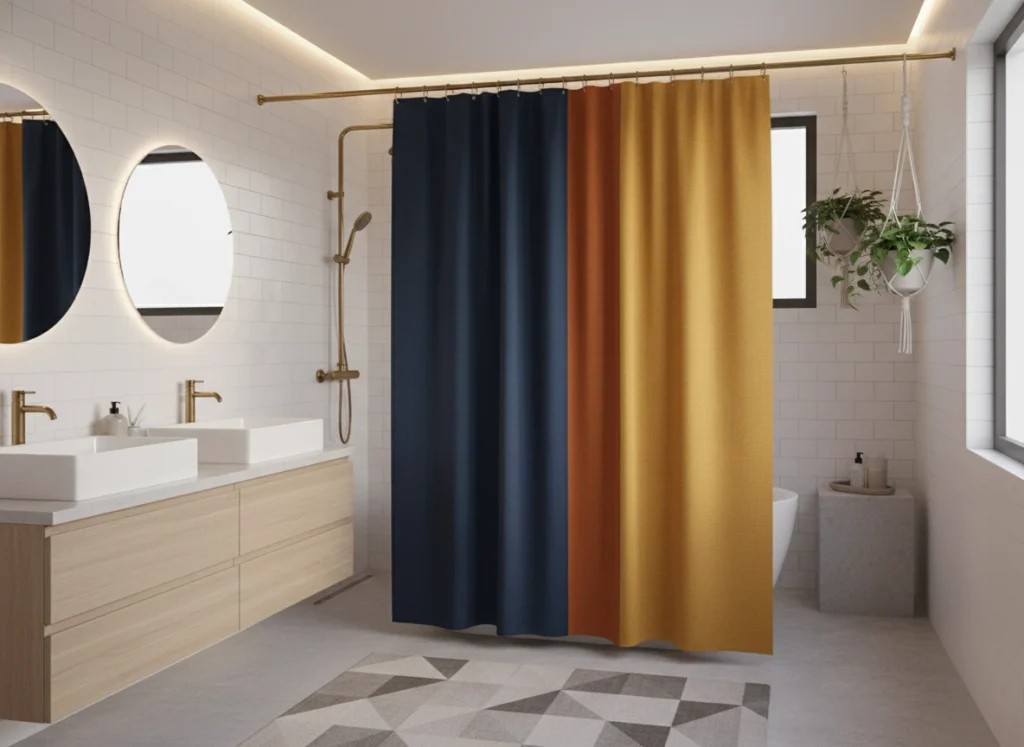
For a modern bathroom, you can still get a luxe winter feel without a single snowflake print.
Choose a double panel shower curtain with bold solid color blocks—navy, rust, mustard, charcoal—then pair it with a simple white liner behind.
The clean vertical bands create a graphic, architectural look that feels fresh but still cozy.
This style works beautifully with sleek fixtures and a double shower curtain rod in black or brass.
Because the pattern is just big blocks of color, it doesn’t fight with your tile, mirrors, or vanity.
You still get all the practical benefits of double shower curtain ideas—extra warmth, better coverage—but in a very design-forward way.
To keep the look intentional, repeat one or two of the curtain colors elsewhere.
Think hand towels in the same deep navy, a bath mat that picks up the warm gold tone, or art with similar hues.
Those small echoes make the curtain feel like part of a carefully planned winter color story, not a random pop of color.
5. Sheer + Pattern Combo on a Double Shower Curtain Rod
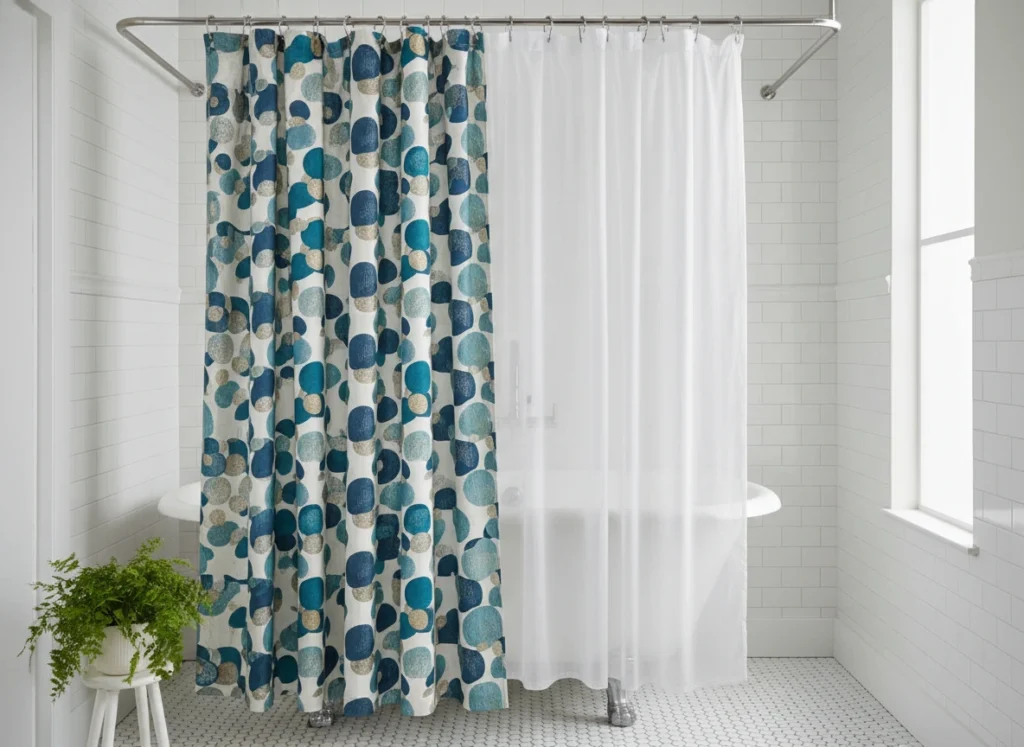
This look is all about depth and softness.
Hang a sheer white curtain on the inner rod, then add a patterned outer curtain—geometrics, botanicals, or even subtle winter motifs—on the front rod.
The sheer layer diffuses light and softens the pattern, so you get interest without overwhelming a small bathroom.
Functionally, this setup behaves like a double panel shower curtain with an extra glow.
The sheer still helps contain warmth and steam, while the patterned curtain gives you privacy and a strong style moment.
It’s a clever twist on classic double shower curtain ideas if you want something playful but still sophisticated.
To keep things luxe rather than busy, let the pattern be the star.
Keep towels and accessories more minimal, and echo just one or two colors from the curtain in your rugs or storage baskets.
Using a sleek double shower curtain rod and simple double shower curtain rings will keep the focus exactly where you want it—on that layered fabric combination.
6. Double Curtain Design for a Walk-In Shower Entry
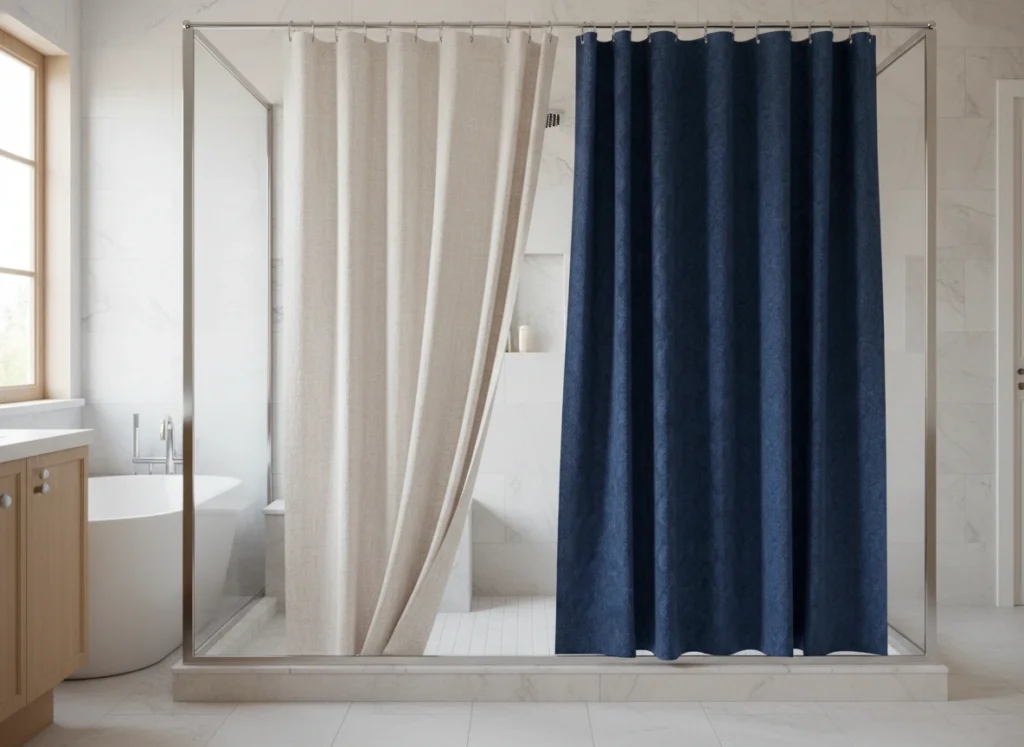
For a walk-in shower, using two curtains that overlap at the entry is both practical and gorgeous.
Hang one curtain on each side of the opening so they meet or cross in the middle, almost like French doors made of fabric.
This double curtain design softens all that hard tile and glass while still letting you slide each panel out of the way when you step in.
In winter, that overlapping fabric acts like a buffer against drafts.
You can pull both panels fully closed to keep warmth and steam inside, which makes a big difference in larger, more open showers.
If you use a double shower curtain rod for walk in shower layouts, you can even add a hidden inner liner for extra splash protection.
Style-wise, you can go tone-on-tone, like a cream panel paired with a deep navy, or keep both panels in the same fabric for a sleek, tailored look.
The vertical lines make the ceiling feel higher, while the layered entry creates a sense of arrival every time you shower.
It’s one of those double shower curtain ideas that looks designer-level but is incredibly straightforward to install.
7. Floor-to-Ceiling Double Panel Shower Curtain for Height and Warmth
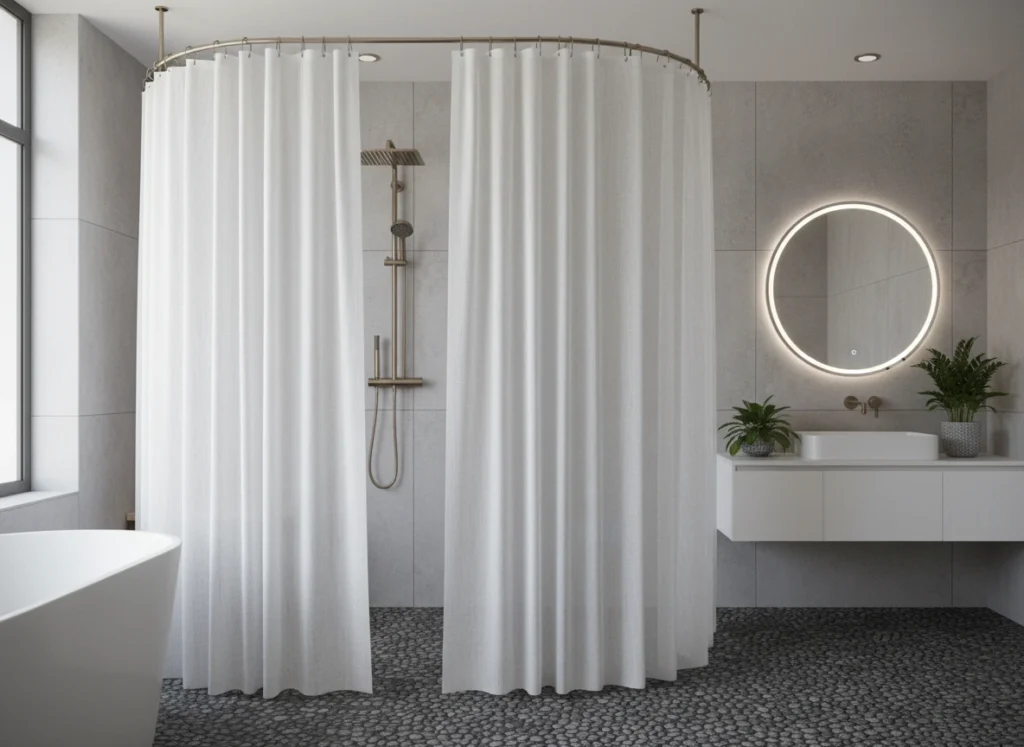
If your ceilings are a decent height, this is one of the most luxurious double shower curtain ideas you can try.
Hang your rod as high as possible and use extra-long double panel shower curtains that just kiss the floor.
The tall columns of fabric instantly make the room feel bigger and more architectural, like a boutique spa.
In winter, all that fabric does a great job of trapping warmth.
Steam rises and stays within the curtain “tower,” so you’re not losing heat through a big gap at the top.
A liner on the inside and a soft, textured outer curtain on the outside turn the shower into a cozy cocoon.
This look pairs beautifully with a double curved shower curtain rod in a warm metal finish.
The curve plus the height creates a dramatic frame around your shower fixtures without feeling fussy.
Just be sure to measure carefully so your curtains are long enough to reach the floor without puddling too much.
8. Cozy Textures: Waffle-Weave or Chenille Double Shower Curtain Ideas
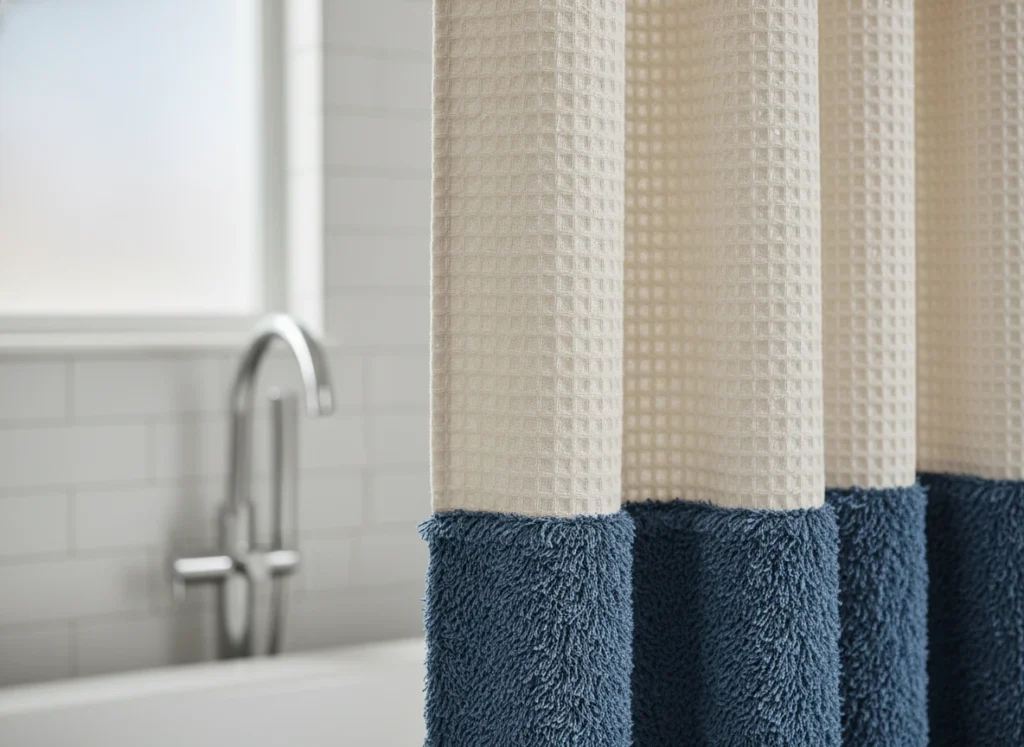
When it’s freezing outside, texture is your secret weapon.
Choose an outer curtain in waffle-weave cotton, chenille, or even a faux-fur trim, then pair it with a smooth inner liner so water still slides right off.
The contrast between the plush outer layer and the sleek inner layer makes your shower feel like a soft, insulated nest.
These cozy fabrics instantly warm up a bathroom that leans hard and minimal—think lots of tile and metal.
A textured double panel shower curtain softens all those straight lines, which is especially welcome in winter when everything else feels a bit stark.
Even in neutral colors, the raised weave and fluffy finishes read as rich and luxurious.
To keep things practical, use texture mostly on the outer curtain.
That way, the inner liner can be a quick-dry or mildew-resistant material that’s easy to wash.
If you love the idea of double shower curtain ideas modern enough for everyday but cozy enough for January, this textured route is a great middle ground.
9. Winter Jewel Tones and Metallic Accents
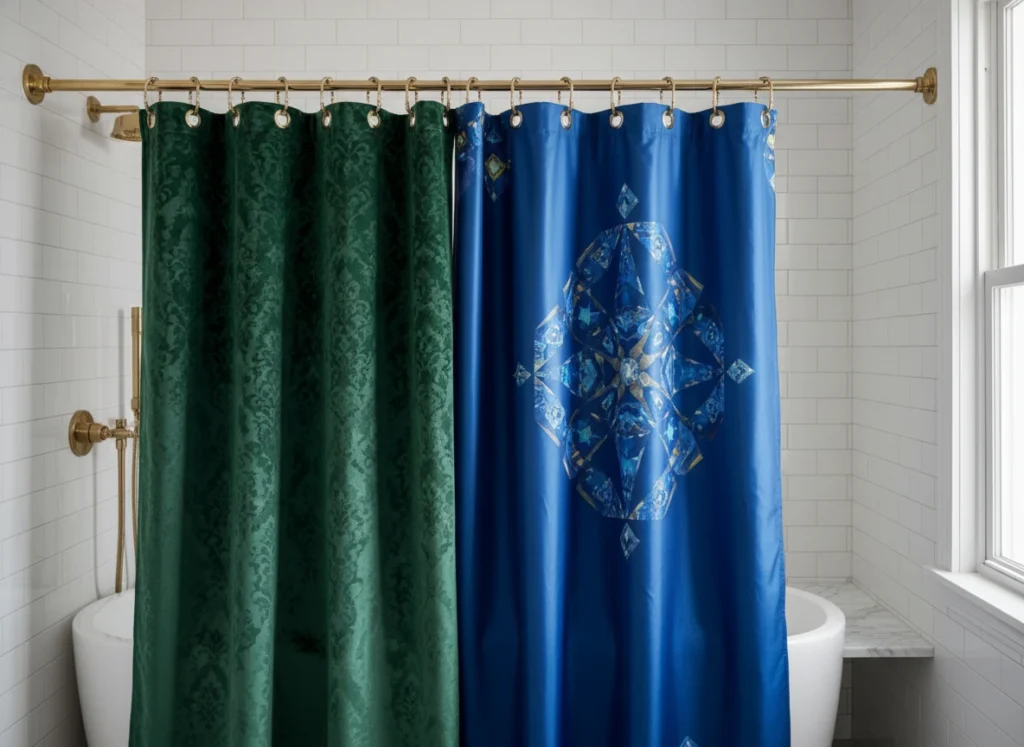
If winter makes your bathroom feel flat and washed out, jewel tones will fix that fast.
Think deep emerald, sapphire, garnet, or amethyst on your outer curtain, paired with a simple liner behind.
On a double shower curtain rod, you can even mix two rich shades—one panel in green, one in blue—for a layered, designer look.
Metallic hardware is what takes this idea from “fun” to “full-on luxe.”
A brass or gold-tone rod, plus shiny double shower curtain rings, echoes the richness of the fabric and catches any available light.
The combination feels festive in winter but still sophisticated enough to keep up all year.
To keep the room balanced, let the double shower curtain be the star and tone things down elsewhere.
Stick to mostly neutral towels and rugs, then add one or two metallic accents like a tray, mirror frame, or soap dispenser.
You’ll get a glamorous, jewel-box bathroom that still feels calm, not chaotic.
10. Small Bathroom Tricks: Half-Panel Double Shower Curtain to Fake More Space
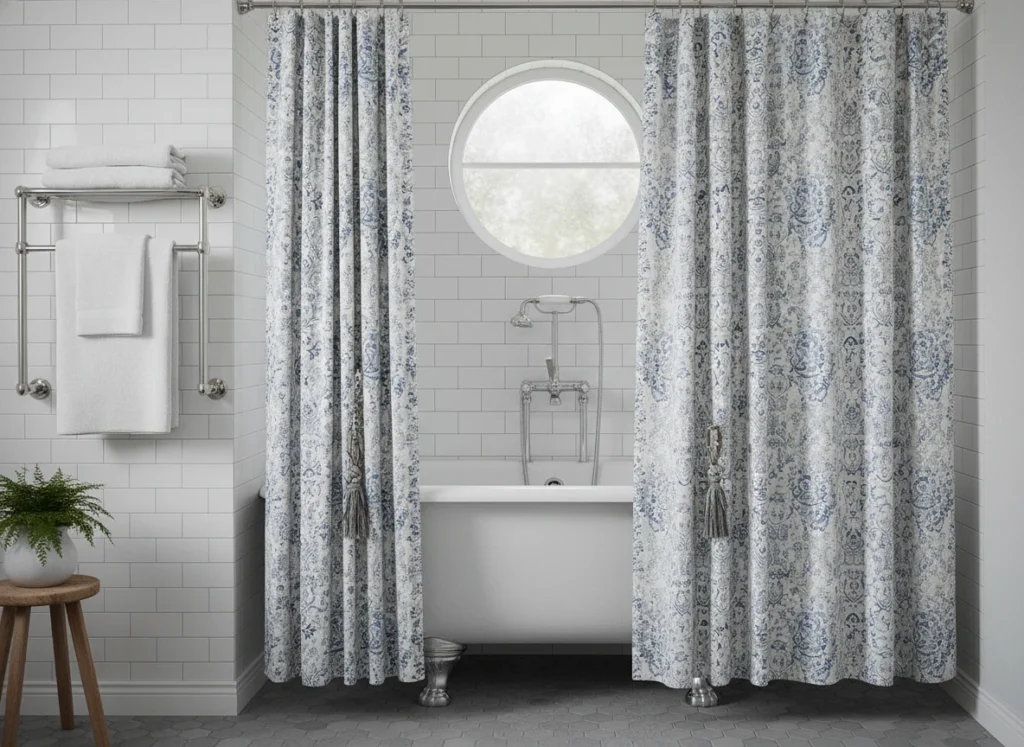
In a tight bathroom, a full wall of fabric can feel heavy.
Instead, try two slightly narrower panels hung on a double shower curtain rod so they sit toward the sides, framing the tub.
When you’re not showering, you can tie them back with tassels or simple tiebacks to reveal more tile and make the room feel wider.
During winter showers, just release the panels and pull them closed to keep warmth and water in.
You still get the cozy benefits of double shower curtain ideas—extra layering, better insulation—but the bathroom doesn’t look boxed in 24/7.
It’s a smart trick if you’re working with a small footprint and want both luxury and breathing room.
For pattern, think delicate prints or soft stripes that don’t overwhelm the space.
Pair patterned outer half-panels with a plain white liner behind, using double hook shower curtain rings so everything moves easily.
This gives you a charming, almost “draped window” effect around the tub, which feels surprisingly upscale in a compact room.
Styling and Accessorizing Your Double Shower Curtain for Winter
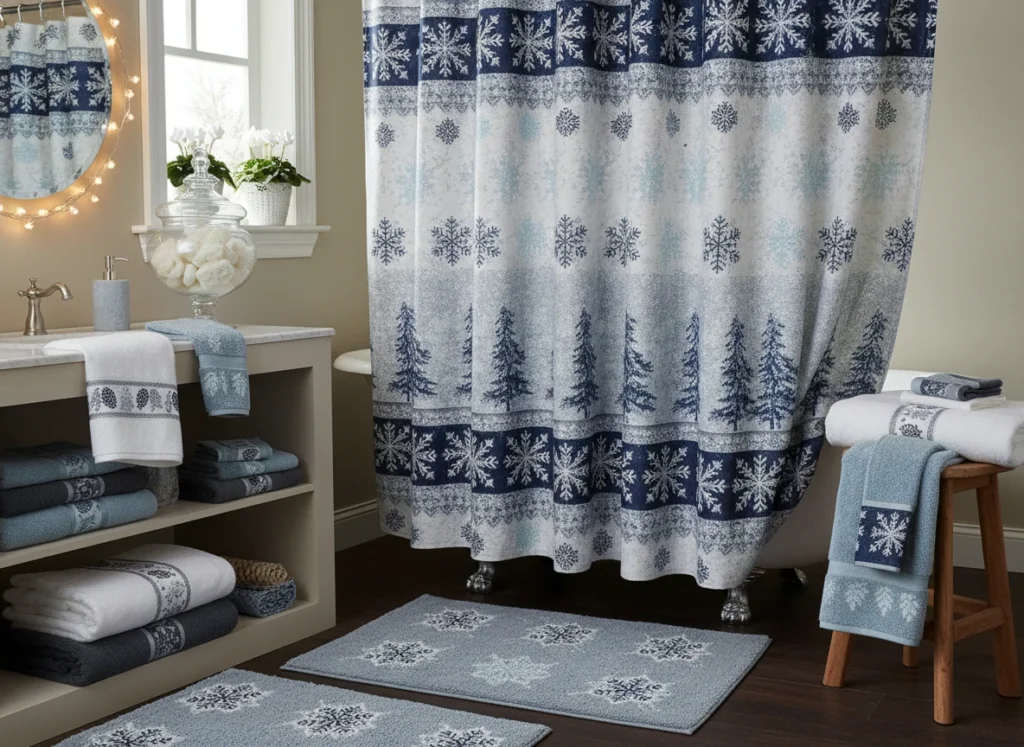
Once your double shower curtain rod and panels are in place, the fun is styling everything around them.
Think of the curtain as your main character and the rugs, towels, and small accessories as the supporting cast.
When they all echo the same colors and mood, your bathroom instantly feels more intentional and luxurious.
Start by repeating two or three colors from your double panel shower curtain in the rest of the room.
If your curtain has navy and icy gray, choose bath mats and hand towels in those shades instead of introducing new ones.
This simple trick makes even affordable double shower curtain ideas look curated and high-end.
Texture matters just as much as color in winter.
Pair a sleek liner and curtain with plush, deep-pile rugs, stacked fluffy towels, and maybe a knit basket for storage.
Those soft layers offset the tile and metal and make stepping out of a hot shower far less shocking on cold mornings.
Finally, sprinkle in a few warm touches to balance the coolness of tile and winter light.
Candles, a wooden stool, woven baskets, or a brass tray all play nicely with double glide shower curtain rings and metallic rods.
The goal isn’t clutter; it’s a handful of cozy accents that make the whole space feel welcoming when it’s freezing outside.
Colors and Prints That Feel Luxe in Cold Weather
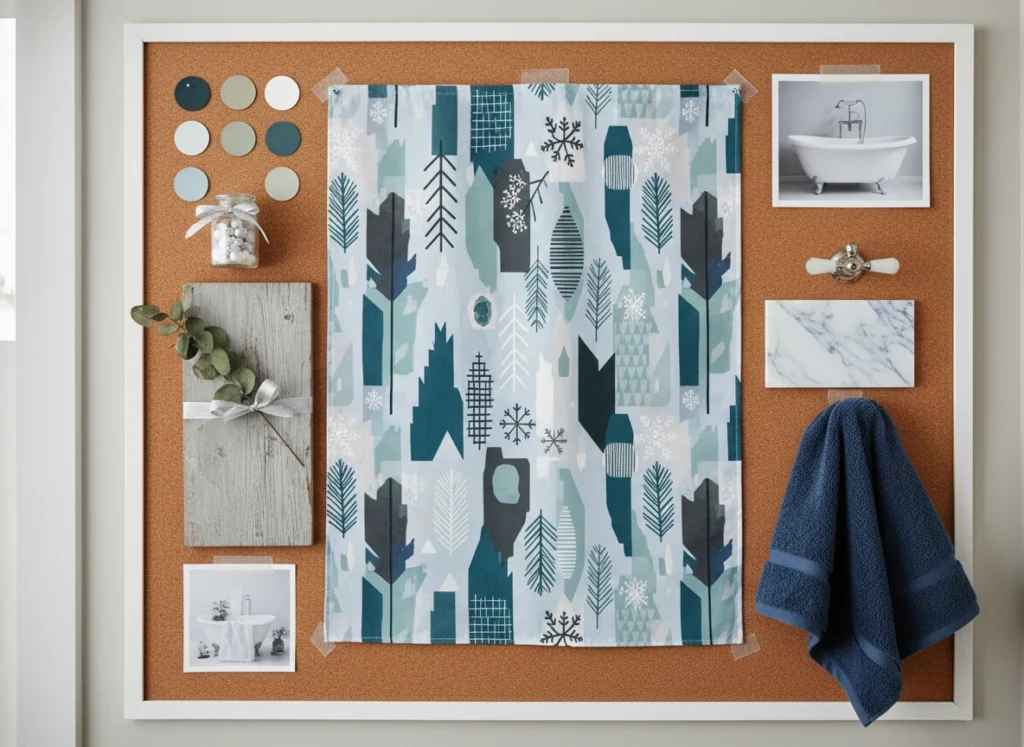
Winter loves a rich, slightly moody color palette.
For double shower curtain ideas, think warm whites, stone, charcoal, forest green, navy, and smoky teal, with maybe a tiny hit of soft blush or gold.
These shades feel cozy and expensive, especially when the rest of the year your bathroom runs lighter and brighter.
Prints can be seasonal without screaming “holiday.”
Geometric patterns, subtle forest or tree motifs, herringbone, or abstract snowflake-inspired designs work beautifully on a double panel shower curtain.
Because you have two layers, you can keep the inner liner plain and let the outer curtain carry all the personality.
If you’re nervous about pattern, use it in moderation.
Choose a mostly solid curtain with a printed border, or stick to small-scale prints in just one or two colors.
That way, your double rod shower curtain ideas still feel luxe and grown-up, not like a temporary novelty curtain.
Layering With Rugs, Towels, and Storage Around the Curtain
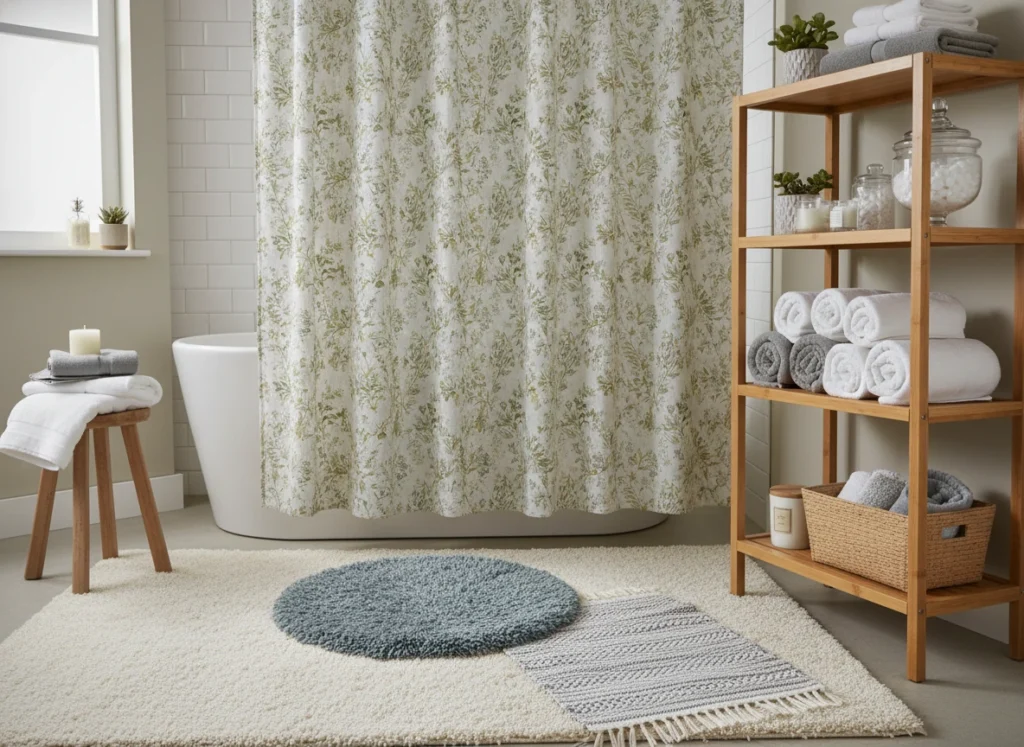
Layers are what turn your double shower curtain setup into a full winter sanctuary.
Place a thick, plush rug or even two overlapping rugs right outside the shower so your feet land somewhere soft and warm.
Then stack rolled towels on open shelves or a ladder rack so they feel like part of the decor, not just storage.
Try echoing the colors of your double panel shower curtain in those layers.
If your curtain has soft greens and creams, choose towels in those tones and maybe a smaller accent rug in a coordinating pattern.
This repetition makes everything feel pulled together, even if each piece came from a different store.
Don’t forget small storage moments.
A woven basket for extra washcloths, a lidded jar for bath salts, or a tray for everyday products keeps clutter under control.
When everything has a home, your double shower curtain ideas read as calm and luxurious, rather than fighting with random bottles on every surface.
Easy Seasonal Switches So You’re Not Stuck With One Look
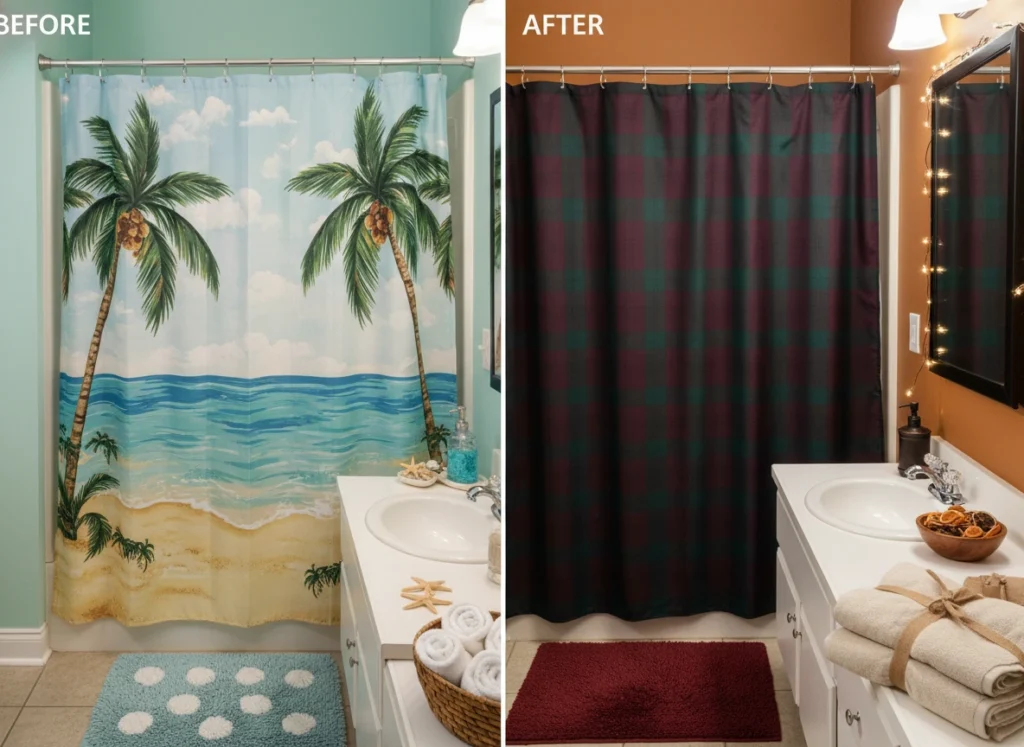
One of the best parts of a double shower curtain setup is how easy it is to change the vibe.
Keep your liner neutral and invest in two or three outer curtains you can rotate: maybe a beachy print for summer, a plaid or knit look for winter, and something simple for spring.
Thanks to double hook shower curtain rings, swapping the outer panel takes just a few minutes.
When winter hits, switch to richer colors and cozier textures—think tartan, velvet-look fabric, or a deep jewel tone.
Add a thicker bath mat, a different hand towel color, and maybe a strand of fairy lights around the mirror.
Suddenly your everyday bathroom feels like a completely different, much warmer space.
You don’t have to repaint or replace tile to get that change.
Your double shower curtain rod and main hardware stay the same; you’re just updating the “clothes” your bathroom wears.
It’s an affordable way to keep your double shower curtain ideas feeling fresh without committing to one look all year long.
Practical Winter Tips: Warmth, Cleaning, and Durability
Double shower curtain ideas are gorgeous, but they still have to survive real life—soap, steam, and the occasional shampoo explosion.
A little planning around warmth, cleaning, and durability will keep your winter setup looking luxe instead of limp.
Think of this section as maintenance tips that protect all the effort you put into choosing that perfect double panel shower curtain.
Choosing Liners and Fabrics That Dry Fast in Winter
In winter, windows stay closed and ventilation often isn’t great, so drying time really matters.
Look for liners labeled mildew-resistant or quick-dry, usually made from polyester or PEVA rather than heavy vinyl.
These materials don’t trap as much moisture, which means less chance of musty smells hiding behind your beautiful outer curtain.
For the decorative layer, pick fabrics that can go right in the washing machine.
Cotton, cotton blends, and polyester work well, especially if they’re not too thick or backed in plastic.
If you love a heavier fabric for warmth, pair it with a lighter liner and crack the curtain open slightly after showers so air can circulate.
Preventing Mold and Mildew Behind Double Curtains
Two layers naturally create a little pocket where moisture can sit if you’re not careful.
After each shower, pull the inner liner fully closed so it can drip into the tub, and let the outer curtain stay partially open to breathe.
This simple habit alone keeps a lot of condensation from lingering.
Build a light cleaning routine into your week.
Wipe down the liner with a 50/50 mix of water and white vinegar, or spray it with a bathroom cleaner while you’re already in there.
Once a month (or more often if your bathroom runs damp), toss the liner and outer curtain into the wash following the care labels.
If you notice spots starting near the hem, don’t ignore them.
Wash the curtain sooner, and consider trimming or replacing liners that are too long and bunch up on the tub floor.
Less pooling fabric means less trapped water and fewer mold-friendly corners.
Budget vs Splurge: Where to Invest for a Luxe Look
Not every part of your double shower curtain setup needs to be high-end.
Save your budget on items that wear out quickly—basic liners, everyday bath mats, and backup towels can be simple and affordable.
You’ll replace them more often anyway, especially in winter when everything stays damp longer.
Where should you splurge?
- A solid, rust-resistant double shower curtain rod (straight or double curved)
- Quality double glide shower curtain rings or double hook shower curtain rings
- At least one really beautiful outer curtain that makes you happy every time you see it
Those pieces define the look and feel of your bathroom.
A great rod and hardware make even budget curtains hang better, and one showpiece outer panel can elevate your entire space.
From there, you can keep experimenting with new double shower curtain ideas modern, classic, or cozy—without starting from scratch each time.
Conclusion – Bringing It All Together
A double shower curtain is a small change with big impact, especially in winter.
Layering a reliable liner with a beautiful outer panel—or even two panels on a double curved shower curtain rod—adds warmth, depth, and that “boutique hotel” feeling every time you step into the shower.
Whether you go for crisp white double panel curtains, jewel-toned drama, or textured waffle-weave, the real magic is in the combo: good hardware, thoughtful fabrics, and accessories that echo your colors.
Add quality double shower curtain rings or double hook shower curtain rings, a plush rug, and a stack of soft towels, and suddenly your bathroom feels less like a utility room and more like a retreat.
You don’t have to tackle every idea at once.
Pick one upgrade—a new outer curtain, a sturdier double shower curtain rod for walk in shower layouts, or better double glide shower curtain rings—and build from there.
By the time the weather turns icy, you’ll have a bathroom that’s not just warm and practical, but quietly, confidently luxe.

